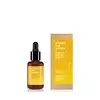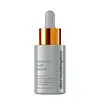What's inside
What's inside
 Key Ingredients
Key Ingredients

 Benefits
Benefits

 Concerns
Concerns

 Ingredients Side-by-side
Ingredients Side-by-side

Water
Skin ConditioningPropanediol
SolventGlycerin
HumectantAcacia Senegal Gum
MaskingLithops Pseudotruncatella Callus Lysate
Skin ConditioningCichorium Intybus Root Extract
MaskingSaccharomyces/Grape Ferment Extract
Skin ConditioningZea Mays Oil
EmulsifyingDaucus Carota Sativa Root Extract
Skin ConditioningCyamopsis Tetragonoloba Gum
Emulsion StabilisingPentylene Glycol
Skin ConditioningHelianthus Annuus Seed Oil
EmollientXanthan Gum
EmulsifyingLactic Acid
BufferingSodium Citrate
BufferingSodium Phytate
1,2-Hexanediol
Skin ConditioningCaprylyl Glycol
EmollientPhytic Acid
Ascorbyl Palmitate
AntioxidantPotassium Sorbate
PreservativeSodium Benzoate
MaskingWater, Propanediol, Glycerin, Acacia Senegal Gum, Lithops Pseudotruncatella Callus Lysate, Cichorium Intybus Root Extract, Saccharomyces/Grape Ferment Extract, Zea Mays Oil, Daucus Carota Sativa Root Extract, Cyamopsis Tetragonoloba Gum, Pentylene Glycol, Helianthus Annuus Seed Oil, Xanthan Gum, Lactic Acid, Sodium Citrate, Sodium Phytate, 1,2-Hexanediol, Caprylyl Glycol, Phytic Acid, Ascorbyl Palmitate, Potassium Sorbate, Sodium Benzoate
Water
Skin ConditioningGlycerin
HumectantPropanediol
SolventTranexamic Acid
AstringentButylene Glycol
HumectantPEG-40 Hydrogenated Castor Oil
EmulsifyingAminopropyl Ascorbyl Phosphate
AntioxidantHydroxyacetophenone
AntioxidantDipotassium Glycyrrhizate
HumectantLactic Acid
BufferingErgothioneine
AntioxidantGlycine Soja Oil
EmollientHelianthus Annuus Seed Oil
EmollientCitrus Nobilis Peel Oil
MaskingRicinus Communis Seed Oil
MaskingChlorella Vulgaris Extract
Skin ConditioningDaucus Carota Sativa Root Extract
Skin ConditioningHydrolyzed Jojoba Esters
Skin ConditioningCichorium Intybus Root Extract
MaskingOpuntia Ficus-Indica Stem Extract
Skin ConditioningCitrus Aurantium Dulcis Fruit Extract
MaskingCitrus Paradisi Fruit Extract
Skin ConditioningCitrus Aurantifolia Oil
CleansingCyamopsis Tetragonoloba Gum
Emulsion StabilisingTocopherol
AntioxidantSodium PCA
HumectantFructooligosaccharides
HumectantBioflavonoids
Skin ConditioningGlycoproteins
Skin ConditioningGlycine
BufferingSqualane
EmollientAscorbyl Methylsilanol Pectinate
AntioxidantCaprylyl Glycol
EmollientBeta-Carotene
Skin ConditioningCystine
MaskingPentylene Glycol
Skin ConditioningMannitol
HumectantErgosterol
Skin ConditioningXanthan Gum
EmulsifyingMethylpropanediol
Solvent1,2-Hexanediol
Skin ConditioningTetrasodium Glutamate Diacetate
Carbomer/Papain Crosspolymer
Phytic Acid
Citric Acid
BufferingSodium Hydroxide
BufferingAcacia Senegal Gum
MaskingPolyacrylate Crosspolymer-6
Emulsion StabilisingAlgin
MaskingDisodium Phosphate
BufferingLimonene
PerfumingCitrus Species Peel Extract
PerfumingWater, Glycerin, Propanediol, Tranexamic Acid, Butylene Glycol, PEG-40 Hydrogenated Castor Oil, Aminopropyl Ascorbyl Phosphate, Hydroxyacetophenone, Dipotassium Glycyrrhizate, Lactic Acid, Ergothioneine, Glycine Soja Oil, Helianthus Annuus Seed Oil, Citrus Nobilis Peel Oil, Ricinus Communis Seed Oil, Chlorella Vulgaris Extract, Daucus Carota Sativa Root Extract, Hydrolyzed Jojoba Esters, Cichorium Intybus Root Extract, Opuntia Ficus-Indica Stem Extract, Citrus Aurantium Dulcis Fruit Extract, Citrus Paradisi Fruit Extract, Citrus Aurantifolia Oil, Cyamopsis Tetragonoloba Gum, Tocopherol, Sodium PCA, Fructooligosaccharides, Bioflavonoids, Glycoproteins, Glycine, Squalane, Ascorbyl Methylsilanol Pectinate, Caprylyl Glycol, Beta-Carotene, Cystine, Pentylene Glycol, Mannitol, Ergosterol, Xanthan Gum, Methylpropanediol, 1,2-Hexanediol, Tetrasodium Glutamate Diacetate, Carbomer/Papain Crosspolymer, Phytic Acid, Citric Acid, Sodium Hydroxide, Acacia Senegal Gum, Polyacrylate Crosspolymer-6, Algin, Disodium Phosphate, Limonene, Citrus Species Peel Extract
Ingredients Explained
These ingredients are found in both products.
Ingredients higher up in an ingredient list are typically present in a larger amount.
1,2-Hexanediol is a synthetic liquid and another multi-functional powerhouse.
It is a:
- Humectant, drawing moisture into the skin
- Emollient, helping to soften skin
- Solvent, dispersing and stabilizing formulas
- Preservative booster, enhancing the antimicrobial activity of other preservatives
Acacia Senegal Gum has skin soothing, thickening, and formulation stabilizing properties. It comes from the Acacia tree that is native to sub-Saharan Africa.
Caprylyl Glycol is a humectant and emollient, meaning it attracts and preserves moisture.
It is a common ingredient in many products, especially those designed to hydrate skin. The primary benefits are retaining moisture, skin softening, and promoting a healthy skin barrier.
Though Caprylyl Glycol is an alcohol derived from fatty acids, it is not the kind that can dry out skin.
This ingredient is also used as a preservative to extend the life of products. It has slight antimicrobial properties.
Learn more about Caprylyl GlycolWe don't have a description for Cichorium Intybus Root Extract yet.
Guar gum is made from the guar bean, a plant native to India. It is considered a form of polysaccharide and naturally contains sugar.
This ingredient is often used to thicken a product or create a gel-like consistency.
It also has emulsion properties to help keep ingredients together.
Learn more about Cyamopsis Tetragonoloba GumDaucus Carota Sativa Root Extract comes from the root commonly known as carrot (the orange kind we eat!).
This extract contains beta-carotene, a pigment responsible for giving plants the orange color. Beta-carotene is a potent antioxidant. Antioxidants may help reduce the signs of aging.
Beta-carotene is the reason we turn orange if we eat too many carrots.
It should be noted coming into contact with the leaves of wild carrots can cause skin irritation. The sap causes phytophotodermatitis, or sensitivity exposed to sunlight.
This ingredient is created using the edible parts of the carrot.
Learn more about Daucus Carota Sativa Root ExtractGlycerin is already naturally found in your skin. It helps moisturize and protect your skin.
A study from 2016 found glycerin to be more effective as a humectant than AHAs and hyaluronic acid.
As a humectant, it helps the skin stay hydrated by pulling moisture to your skin. The low molecular weight of glycerin allows it to pull moisture into the deeper layers of your skin.
Hydrated skin improves your skin barrier; Your skin barrier helps protect against irritants and bacteria.
Glycerin has also been found to have antimicrobial and antiviral properties. Due to these properties, glycerin is often used in wound and burn treatments.
In cosmetics, glycerin is usually derived from plants such as soybean or palm. However, it can also be sourced from animals, such as tallow or animal fat.
This ingredient is organic, colorless, odorless, and non-toxic.
Glycerin is the name for this ingredient in American English. British English uses Glycerol/Glycerine.
Learn more about GlycerinHelianthus Annuus Seed Oil is the oil derived from the seeds of a Sunflower. Sunflower seed oil is non-fragrant. It is an emollient, meaning it helps to soften the skin.
Sunflower seed oil contains many fatty acids. The fatty acids found in sunflower seeds include (from highest amount to least): linoleic acid, myristic acid, palmitic acid, stearic acid, arachidic acid, oleic acid, and linolenic acid.
These fatty acids help the skin create ceramides. Ceramides play a role in repairing the skin barrier.
Helianthus Annuus Seed Oil helps moisturize the skin. This in turn helps the skin look more rejuvenated and smoother.
Sunflowers are rich in vitamin E.
Historians believe Indigenous cultures of North America domesticated sunflowers before corn. Thus they relied on sunflower oil for a variety of uses. One such use is moisturizing skin and hair.
Sunflower seed oil may not be fungal acne safe. We recommend speaking with a professional if you have any concerns.
Learn more about Helianthus Annuus Seed OilLactic Acid is another well-loved alpha hydroxy acid (AHA). It is gentler than glycolic acid but still highly effective.
Its main role is to exfoliate the surface of the skin by loosening the “glue” that holds dead skin cells together. Shedding those old cells leads to smoother, softer, and more even-toned skin.
Because lactic acid molecules are larger than glycolic acid, they don’t penetrate as deeply. This means they’re less likely to sting or irritate, making it a great choice for beginners or those with sensitive skin.
Like glycolic acid, it can:
Lactic acid also acts as a humectant (like hyaluronic acid). It can draw water into the skin to improve hydration and also plays a role in the skin's natural moisturizing factor (NMF) in the form of sodium lactate.
Studies show it can boost ceramide production to strengthen the skin barrier and even help balance the skin’s microbiome.
To get results, choose products with a pH between 3-4.
Lower strengths (5-12%) focus on surface exfoliation; higher strengths (12% and up) can reach deeper in the dermis (deeper, supportive layer) to improve skin texture and firmness over time.
Though it was originally derived from milk, most modern lactic acid used in skincare is vegan. It is made through non-dairy fermentation to create a bio-identical and stable form suitable for all formulations.
When lactic acid shows up near the end of an ingredient list, it usually means the brand added just a tiny amount to adjust the product’s pH.
Legend has it that Cleopatra used to bathe in sour milk to help reduce wrinkles.
Lactic acid is truly a gentle multitasker: it exfoliates, hydrates, strengthens, and brightens. It's a great ingredient for giving your skin a smooth, glowing, and healthy look without the harshness of stronger acids.
Read more about some other popular AHA's here:
Learn more about Lactic AcidPentylene glycol is typically used within a product to thicken it. It also adds a smooth, soft, and moisturizing feel to the product. It is naturally found in plants such as sugar beets.
The hydrophilic trait of Pentylene Glycol makes it a humectant. As a humectant, Pentylene Glycol helps draw moisture from the air to your skin. This can help keep your skin hydrated.
This property also makes Pentylene Glycol a great texture enhancer. It can also help thicken or stabilize a product.
Pentylene Glycol also acts as a mild preservative and helps to keep a product microbe-free.
Some people may experience mild eye and skin irritation from Pentylene Glycol. We always recommend speaking with a professional about using this ingredient in your routine.
Pentylene Glycol has a low molecular weight and is part of the 1,2-glycol family.
Learn more about Pentylene GlycolPhytic Acid is a gentle AHA and antioxidant. AHAs are chemical exfoliants that help remove dead skin cells. Phytic Acid has a slight and mild exfoliating effect.
The chemical makeup makes it classified as an AHA, much like lactic acid.
In some cases, it is a chelating agent. Chelating agents help prevent metals from binding to water, helping to stabilize the ingredients in a product.
An interesting fact about phytic acid is that it is considered an antinutrient. People do not have the enzyme needed to properly breakdown and digest phytic acid. When ingested, phytic acid binds to minerals and prevents them from being absorbed.
Read more about some other popular AHA's here:
Learn more about Phytic AcidPropanediol is an all-star ingredient. It softens, hydrates, and smooths the skin.
It’s often used to:
Propanediol is not likely to cause sensitivity and considered safe to use. It is derived from corn or petroleum with a clear color and no scent.
Learn more about PropanediolWater. It's the most common cosmetic ingredient of all. You'll usually see it at the top of ingredient lists, meaning that it makes up the largest part of the product.
So why is it so popular? Water most often acts as a solvent - this means that it helps dissolve other ingredients into the formulation.
You'll also recognize water as that liquid we all need to stay alive. If you see this, drink a glass of water. Stay hydrated!
Learn more about WaterXanthan gum is used as a stabilizer and thickener within cosmetic products. It helps give products a sticky, thick feeling - preventing them from being too runny.
On the technical side of things, xanthan gum is a polysaccharide - a combination consisting of multiple sugar molecules bonded together.
Xanthan gum is a pretty common and great ingredient. It is a natural, non-toxic, non-irritating ingredient that is also commonly used in food products.
Learn more about Xanthan Gum